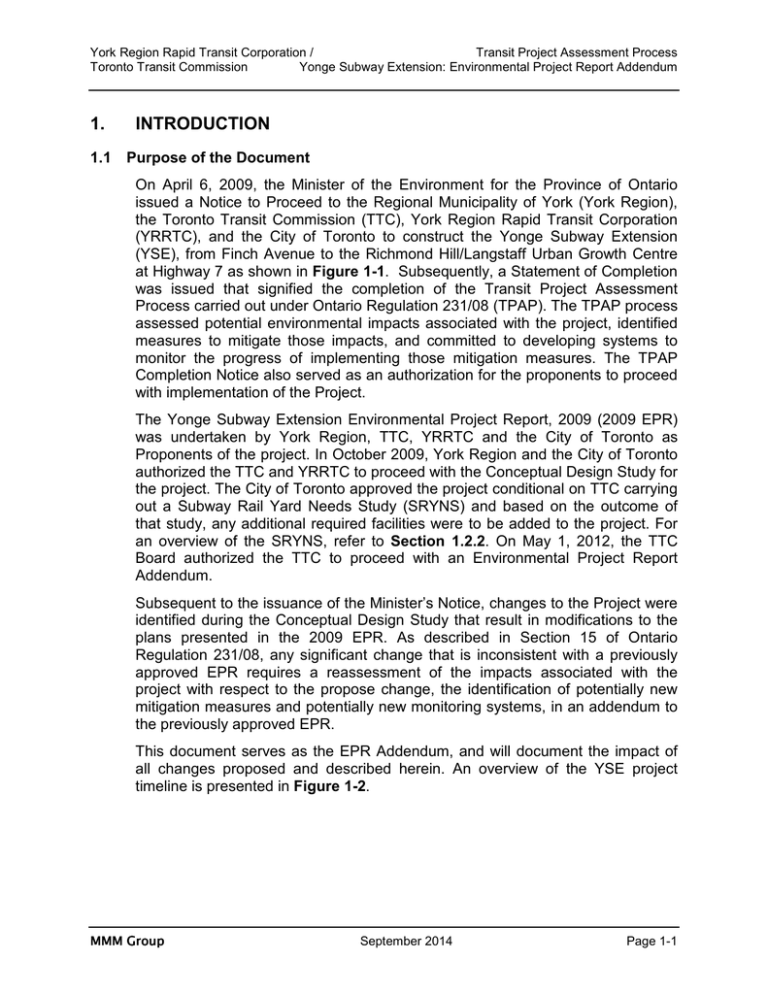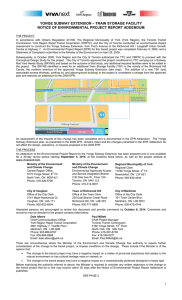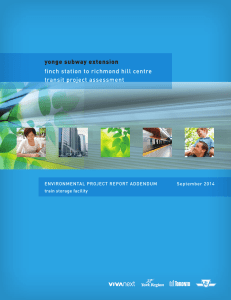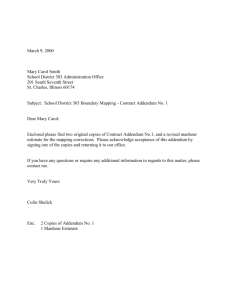York Region Rapid Transit Corporation / Transit Project Assessment Process
advertisement

York Region Rapid Transit Corporation / Transit Project Assessment Process Toronto Transit Commission Yonge Subway Extension: Environmental Project Report Addendum 1. 1.1 INTRODUCTION Purpose of the Document On April 6, 2009, the Minister of the Environment for the Province of Ontario issued a Notice to Proceed to the Regional Municipality of York (York Region), the Toronto Transit Commission (TTC), York Region Rapid Transit Corporation (YRRTC), and the City of Toronto to construct the Yonge Subway Extension (YSE), from Finch Avenue to the Richmond Hill/Langstaff Urban Growth Centre at Highway 7 as shown in Figure 1-1. Subsequently, a Statement of Completion was issued that signified the completion of the Transit Project Assessment Process carried out under Ontario Regulation 231/08 (TPAP). The TPAP process assessed potential environmental impacts associated with the project, identified measures to mitigate those impacts, and committed to developing systems to monitor the progress of implementing those mitigation measures. The TPAP Completion Notice also served as an authorization for the proponents to proceed with implementation of the Project. The Yonge Subway Extension Environmental Project Report, 2009 (2009 EPR) was undertaken by York Region, TTC, YRRTC and the City of Toronto as Proponents of the project. In October 2009, York Region and the City of Toronto authorized the TTC and YRRTC to proceed with the Conceptual Design Study for the project. The City of Toronto approved the project conditional on TTC carrying out a Subway Rail Yard Needs Study (SRYNS) and based on the outcome of that study, any additional required facilities were to be added to the project. For an overview of the SRYNS, refer to Section 1.2.2. On May 1, 2012, the TTC Board authorized the TTC to proceed with an Environmental Project Report Addendum. Subsequent to the issuance of the Minister’s Notice, changes to the Project were identified during the Conceptual Design Study that result in modifications to the plans presented in the 2009 EPR. As described in Section 15 of Ontario Regulation 231/08, any significant change that is inconsistent with a previously approved EPR requires a reassessment of the impacts associated with the project with respect to the propose change, the identification of potentially new mitigation measures and potentially new monitoring systems, in an addendum to the previously approved EPR. This document serves as the EPR Addendum, and will document the impact of all changes proposed and described herein. An overview of the YSE project timeline is presented in Figure 1-2. MMM Group September 2014 Page 1-1 York Region Rapid Transit Corporation / Transit Project Assessment Process Toronto Transit Commission Yonge Subway Extension: Environmental Project Report Addendum Figure 1-1: Approved Yonge Subway Extension Plan Figure 1-2: Train Storage Facility Addendum Project Timeline MMM Group September 2014 Page 1-2 York Region Rapid Transit Corporation / Transit Project Assessment Process Toronto Transit Commission Yonge Subway Extension: Environmental Project Report Addendum 1.2 Background 1.2.1 General As illustrated in Figure 1-1, the approved YSE project from Finch Avenue to the Richmond Hill Centre at Highway 7 is 7.42 km in length, with 1.61 km in the City of Toronto (south of Steeles Avenue) and 5.81 km in York Region (north of Steeles Avenue). The project comprises a total of 5.08 km of twin-bored tunnel, five stations, associated track work, two major bus terminals, two bus loops, five substations, eight emergency exit buildings (EEBs) and one bridge. The proposed subway extension will be underground for its entire length, with the exception of the crossing of the East Don River where the subway emerges from the tunnels and crosses the river valley via a two-level bridge with automobile traffic on the upper level and subway on the lower level. The subway level of the bridge will be enclosed to maintain the integrity of the tunnel ventilation system and to mitigate against noise transfer to the surrounding community. Between Finch Station and Langstaff Station, the alignment will run below Yonge Street. North of Langstaff Station, the subway alignment will shift east of Yonge Street to the preferred location for Richmond Hill Centre Station. The alignment of the proposed subway extension and the location of the Richmond Hill Centre Station protected for a future extension northerly towards the intersection of Yonge Street and 16th Avenue / Carville Road. 1.2.2 Subway Rail Yard Needs Study The TTC conducted a SRYNS in May 2009 to identify the vehicle storage capacity of their existing facilities, and evaluate requirements and potential alternative locations for future storage and maintenance facilities. The train yard capacities were assessed based on 2030 vehicle storage requirements and included both the Spadina and Yonge Subway Extensions. It was determined that the train car fleet would grow from 62 trains to a total of 88 trains. The increase will be driven by the following key factors: • A gradual increase in service frequency with Automatic Train Operation (ATO); • The additional fleet needed for the Spadina Subway Extension; • The YSE from Finch Station to Richmond Hill Centre Station, and • The relocation of the current Spadina Subway short turn from St. Clair West Station to Glencairn Station. The study concluded that a 14-train Train Storage Facility (TSF) would be required, and the preferred site for the TSF was identified to be in the vicinity of the Richmond Hill Centre. Considerations for siting the TSF are shown in Figure 1-3. MMM Group September 2014 Page 1-3 York Region Rapid Transit Corporation / Toronto Transit Commission Transit Project Assessment Process Yonge Subway Extension: Environmental Project Report Addendum Figure 1-3: SRYNS Storage Facility Considerations MMM Group September 2014 Page 1-4 York Region Rapid Transit Corporation / Transit Project Assessment Process Toronto Transit Commission Yonge Subway Extension: Environmental Project Report Addendum 1.2.3 Conceptual Design In October 2009, York Region and the City of Toronto authorized the TTC and YRRTC to proceed with the Conceptual Design Study for the YSE. MMM Group (formerly McCormick Rankin Corporation) and Hatch Mott MacDonald were retained by the TTC and YRRTC to carry out the work. The Conceptual Design Study built upon the functional design included in the TPAP to further develop station concepts, property needs, and cost estimates. The study also assessed options to accommodate TTC train storage requirements identified in the TTC SRYNS. Various train storage locations were studied, and the preferred site for the TSF was identified to be in the vicinity of the Richmond Hill Centre. As part of the conceptual design study, an assessment of alternative TSF sites was undertaken. This assessment resulted in the recommended changes to the YSE project being addressed by this EPR Addendum, as described in Section 1.4. A summary of the assessment undertaken in the Conceptual Design Study, and a detailed description of the recommended alternative are provided in Section 3. The Conceptual Design Report can be found on the project website at http://www.vivanext.com/yonge-subway-extension. 1.3 Relevant Planning Policies and Documents 1.3.1 Province of Ontario Planning Process The Province began addressing rapid growth in the Toronto region and throughout the province by enacting the Places to Grow Act, 2005 and the Greenbelt Act, 2005. These land planning reforms established new frameworks for directing urban growth into designated areas while preserving natural and agricultural landscapes. The desired outcome is a substantial increase in the development density in areas designated for growth. The change in growth from lower density sprawl to higher levels of urban density will place an even greater strain on existing urban infrastructure that already operates at capacity, notably the transportation network. To alleviate the fragmented system of planning, funding, and implementation of the region’s urban infrastructure, the Province enacted the Metrolinx Act, 2006. The Act created Metrolinx, a regional planning and funding agency for all modes of transportation identified in the region’s long-term transportation plan, including the five-year capital investment program, and is responsible for implementation, ownership, and operation of all transportation projects identified in the plan. The Ministry of Transportation Ontario and Infrastructure Ontario, a crown corporation, both have critical roles in delivering the provincial urban growth and transportation investment strategies, and in implementing the Metrolinx program. Specifically, Infrastructure Ontario leverages Alternative Financing and MMM Group September 2014 Page 1-5 York Region Rapid Transit Corporation / Transit Project Assessment Process Toronto Transit Commission Yonge Subway Extension: Environmental Project Report Addendum Procurement (AFP1) in the implementation of transportation projects. The Ministry of Transportation Ontario is responsible for transportation infrastructure and policy at the provincial level and serves as the conduit for the Province’s investment in Metrolinx-funded transportation improvements. In addition, the Infrastructure Ontario’s Growth Secretariat is also charged with carrying out the provincial land use and growth planning mandates of the Places to Grow Act, 2005 that serves as the basis for integrated transportation and land use planning. Numerous agencies are responsible for the local delivery of transportation, and the frameworks for delivering the multi-modal transportation system remain devolved to local implementation agencies. The provincial Acts mentioned above are supported by the current Provincial Policy Statement (2014) with policies that set out the government’s land use vision for how Ontario settles our landscape, creates our built environment, and manages our land and resources over the long term to achieve livable and resilient communities. The Provincial Policy Statement (2014) includes policy to promote the use of active transportation, transit and transit-supportive development, and provide for connectivity among transportation modes. On June 15, 2007, the Province of Ontario announced $17.5 billion in funding transit projects for the Greater Toronto Area and Hamilton. Named ‘MoveOntario 2020’, this 12-year provincial investment strategy to deliver 52 Rapid Transit projects in the Greater Toronto and Hamilton Area that forms the geographic area in which Metrolinx has the mandate to develop a comprehensive multimodal transportation network. The Metrolinx Big Five Program was the transit capital investment program originally developed for the first five years of the implementation of the Big Move, the region’s long-term transportation plan. The scope of the Big Five Program included four projects within the City of Toronto (City) and one project in York Region which would be funded through MoveOntario 2020. The Metrolinx Regional Transportation Plan named “The Big Move: Transforming Transportation in the Greater Toronto and Hamilton Area” was approved on November 28, 2008. The plan identified the Yonge North Subway Extension as one of the top 15 priority projects as part of the regional transit expansion. Additional information is available online at: www.metrolinx.com/thebigmove. Metrolinx has subsequently identified a series of “Next Wave” transit infrastructure projects. The Next Wave projects were selected “through a business case analysis and in cooperation with municipal needs”, and includes the Yonge Subway Extension project as approved in the 2009 EPR. 1 From www.infrastructureontario.ca, “AFP is an innovative way of financing and procuring large, complex public infrastructure projectsKUnder AFP, provincial ministries and / or agencies establish the scope and purpose of the project while the work is financed and carried out by the private sector. Only after a project is completed will the private sector company be repaid by the provinceKAFP allows large, complex infrastructure projects to be delivered faster and more efficiently (at a lower, long-term net cost) than traditional procurement, protects taxpayers from cost overruns, and transfers risks to the partner who has the expertise, experience and ability to handle that risk best.” MMM Group September 2014 Page 1-6 York Region Rapid Transit Corporation / Transit Project Assessment Process Toronto Transit Commission Yonge Subway Extension: Environmental Project Report Addendum 1.3.2 Region of York Planning Policies North of Steeles Avenue, land use designations along Yonge Street are subject to change in order to accommodate growth in a more sustainable manner. As the study area for the EPR Addendum is located north of Steeles Avenue, as detailed in Section 1.4.1, this section focuses on York Region planning policy. The Province’s Places to Grow: Growth Plan for the Greater Golden Horseshoe encourages new development to occur within existing built areas and designated Urban Growth Centres throughout the Greater Toronto Area. York Region’s Official Plan establishes an urban structure for the Region which consists of Regional Centres that are connected by Regional Corridors. The Official Plan promotes the intensification of these Centres and Corridors, which maximize land and infrastructure in a matter that supports rapid transit. The structure of the Official Plan designates lands located to the east of the Highway 407 and Yonge Street interchange as a Regional Centre. Richmond Hill Centre / Langstaff Gateway is one of the four Regional Centres intended to act as hubs and equivalent to ‘downtowns’ for business, cultural, government and social activity. These Regional Centres act as focal points since they contain the highest concentrations and intensities of residential, social service, commercial and office activities. In addition, these Regional Centres are to be compact, pedestrian oriented, safe and accessible. One of the Growth Centres is the Richmond Hill / Langstaff Gateway which is located along Highway 7 and adjacent to the subway extension route. Due to existing transit linkages, planned transit improvements and the Growth Plan’s target of 200 jobs and residents per hectare, there are significant opportunities for transit oriented development. In support of provincial legislation, York Region and its municipalities are evaluating and updating their policies. Regional Official Plan Amendment 43 to the Official Plan (ROPA 43), adopted in December 2004, permits intensified land uses up to 2.5 floors space index within designated areas along the Yonge Street and Highway 7 corridors. The land uses along these corridors are subject to the studies conducted by local municipalities, specifically Markham, Newmarket, Richmond Hill, and Vaughan. The Region’s Official Plan designates Yonge Street as a Regional Corridor and the Region envisions rapid transit service will be provided on Yonge Street to serve this Corridor. The development of high-density uses along the corridor will support the introduction of a rapid transit system along the Yonge Street Corridor. 1.4 1.4.1 Changes to the Project Study Area The Study Area for the TSF has evolved over a number of studies related to the YSE project. The Project Team, through the SRYNS, identified at a high-level the area in which the proposed TSF was required (i.e. in the vicinity of the MMM Group September 2014 Page 1-7 York Region Rapid Transit Corporation / Transit Project Assessment Process Toronto Transit Commission Yonge Subway Extension: Environmental Project Report Addendum Richmond Hill Centre, near the northern end of the proposed YSE). Through the subsequent Conceptual Design Study, the Team developed a series of feasible TSF concepts within that high-level study area. The assessment of the feasible TSF concepts (summarized in Section 3) resulted in the identification of a preferred TSF location and layout. The Study Area for the EPR Addendum was generally defined as the area from the proposed Richmond Hill Centre Station (as approved in the 2009 EPR) northerly to 16th Avenue, as presented in Figure 1-4. The Study Area for this EPR Addendum encompasses the area where physical or operational impacts are anticipated as a result of the implementation of the preferred TSF (i.e. the proposed change to the plan presented in the 2009 EPR). 1.4.2 Summary of Proposed Changes This Addendum focuses only on changes to the 2009 EPR proposed in the section north of the proposed Richmond Hill Centre Station to approximately Northern Heights Drive. The following is a summary of the components of the proposed changes to the approved YSE project addressed in this Addendum: • Extension of the YSE alignment to approximately 1km north of the approved Richmond Hill Centre Station; • Underground Train Storage Facility (TSF) for 14 trains, on the YSE alignment north of the approved Richmond Hill Centre Station; • Maintenance building for staff access to the proposed TSF east of Coburg Crescent, and associated 25-30 space employee parking lot; • Private access roadway connecting the proposed TSF employee parking lot to Beresford Drive; • Ventilation shaft in the vicinity of the northern end of the TSF; and • Emergency Exit Building. These proposed changes are discussed in further detail in Section 3.2. MMM Group September 2014 Page 1-8 Study Area . Carrville Rd 7 ay w h Hig Richmond Hill Station 16th Ave. nt ry A ve. Ba hte ch Rd. Yonge St. Hig . 7 d. E y 40 R a f f w a h Hig gst Lan Approved YSE Alignment CN-GO Tracks Extent of YSE Study ks rac T -GO CN Red Maple Rd. 1-4 ADDENDUM STUDY AREA York Region Rapid Transit Corporation / Transit Project Assessment Process Toronto Transit Commission Yonge Subway Extension: Environmental Project Report Addendum This page intentionally left blank. MMM Group September 2014 Page 1-10 York Region Rapid Transit Corporation / Transit Project Assessment Process Toronto Transit Commission Yonge Subway Extension: Environmental Project Report Addendum 1.4.3 Studies Prepared in Support of the YSE TPAP Addendum The following is a list of studies that were conducted in support of this Addendum report: 1.5 • Natural Environment Memo, see Appendix A; • Air Quality Assessment, see Appendix B; • Noise and Vibration Assessment, see Appendix C; • Contamination Overview Study, see Appendix D; • Geotechnical Report, see Appendix E; • Groundwater Assessment Report, see Appendix F; • Stage 1-2 Archaeological Assessment Report, see Appendix G; and, • Cultural Heritage Assessment Memo, see Appendix H. TPAP Addendum Process This TPAP Addendum is being carried out under the Transit Project Assessment Process (TPAP), Ontario Regulation (O. Reg.) 231/08. The EPR for this study was approved by the Ministry of the Environment (MOE, now the Ministry of the Environment and Climate Change [MOECC]) in 2009. As described in Section 1.2, the background studies undertaken since the completion of the TPAP have concluded that modifications to the 2009 EPR are required. As described in Section 15 of O. Reg. 231/08, any significant change that is inconsistent with a previously approved EPR requires a reassessment of the impacts associated with the project where changes are proposed; including the identification of potentially new mitigation measures, and potentially new monitoring systems which are to be documented in an addendum to the previously approved EPR. The formal public and agency review processes and timelines for finalizing an Addendum to an approved EPR are essentially the same as the TPAP; however, the proponent has discretion regarding the scope of public consultation. The following are the key steps in the TPAP Addendum process: • Complete assessment and evaluation of any impacts the change might have on environment; • Complete EPR Addendum report; • Prepare and distribute a Notice of EPR Addendum; and • Final review by stakeholders prior to proceeding with Project. In addition to these steps, consultation has been undertaken to review the proposed changes, potential impacts and proposed mitigation with the public, agencies and stakeholders prior to the completion of this report. MMM Group September 2014 Page 1-11 York Region Rapid Transit Corporation / Transit Project Assessment Process Toronto Transit Commission Yonge Subway Extension: Environmental Project Report Addendum 1.5.1 Content of the Environmental Project Report Addendum In accordance with O. Reg. 231/08, Section 15 (1), if after submitting a statement of completion of the transit project assessment process, the proponent wishes to make a change to the transit project that is inconsistent with the EPR referred to in that statement, the proponent shall prepare an addendum to the EPR. This Addendum to the 2009 EPR contains the following information: 1.5.2 • A description of the change (See Section 1.4); • The reasons for the change (See Section 1.0); • The proponent’s assessment and evaluation of any impacts that the change might have on the environment (See Section 5.0); • A description of any measures proposed by the proponent for mitigating any negative impacts that the change might have on the environment (See Section 5.0); and • A statement of whether the proponent is of the opinion that the change is a significant change to the transit project, and the reasons for the opinion. O. Reg. 231/08, s. 15 (1) (See Section 1.5.2). Updated Project Description Results in Significant Changes In accordance with Section 15 of O. Reg. 231/08, the Proponent has assessed the significance of the changes to the Project. The changes have been deemed significant as the environmental effects of the TSF were not addressed in the 2009 EPR. The addition of the TSF also requires an extension to the YSE footprint by approximately 1km north of the approved Richmond Hill Centre Station. The environmental effects of this change were not specifically addressed in the 2009 EPR. 1.5.3 EPR Addendum Process Upon publishing the Notice of EPR Addendum the report will be made available to the public, regulatory agencies, Aboriginal communities or and other stakeholders for a 30 day public review period in accordance with O. Reg. 231/08. The Minister of the Environment is required to consider any written objections received within 30 days after the Notice of EPR Addendum is first published. Objections with respect to the significant change documented through the EPR Addendum will be considered if the Minister decides to act in respect of the significant change. The Minister may act if the significant change may have a negative impact on a matter of provincial importance that relates to the natural environment or has cultural heritage value or interest, or on a constitutionally protected Aboriginal or treaty right. Following the 30-day public comment period, the Minister of the Environment has 35 days to issue one of three notices: MMM Group September 2014 Page 1-12 York Region Rapid Transit Corporation / Transit Project Assessment Process Toronto Transit Commission Yonge Subway Extension: Environmental Project Report Addendum 1. a notice allowing the proponent to change the transit project in accordance with the addendum; 2. a notice requiring further consideration of the change described in the addendum; or 3. a notice allowing the proponent to change the transit project in accordance with the addendum, subject to conditions set out in the notice. Further detail regarding the EPR Addendum process is provided in Section 15 of O. Reg. 231/08. MMM Group September 2014 Page 1-13 York Region Rapid Transit Corporation / Transit Project Assessment Process Toronto Transit Commission Yonge Subway Extension: Environmental Project Report Addendum This page intentionally left blank. MMM Group September 2014 Page 1-14




